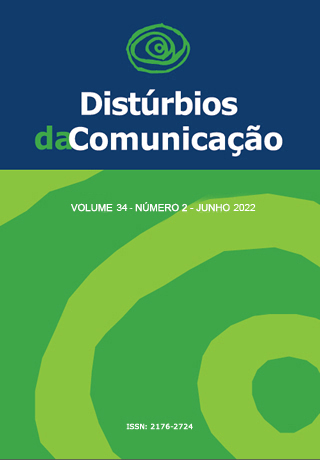Jogo de espelhos
a interferência dos estereótipos na fala dos comunicadores de rádio e podcast
DOI:
https://doi.org/10.23925/2176-2724.2022v34i2e54784Palavras-chave:
Voz, Rádio, Estereotipagem, Comunicação, Webcast, Fala, Percepção de FalaResumo
Introdução: Ouvintes de rádio e podcast deduzem traços de personalidade quando ouvem os apresentadores, a partir exclusivamente da fala desses profissionais. Objetivo: Identificar os fatores que interferem na atribuição de características de personalidade a partir da voz, e discutir como o julgamento do público pode modificar a performance dos apresentadores de rádio e podcast. Método: Por meio de um levantamento bibliográfico inicial, foram apresentadas referências bibliográficas sobre pesquisas de julgamento de voz, considerando aspectos socioculturais e de gênero, e a interferência dos estereótipos no comportamento e na fala dos indivíduos. Resultados: Pesquisas de julgamento de personalidade pela voz indicam que a avaliação dos ouvintes se baseia nos traços de personalidade mais marcantes e valorizados socialmente, ou seja, os estereótipos. Considerando que os mesmos valores são compartilhados também pelos comunicadores, é possível supor que esses procurem imprimir na sua fala características que agradem ao público. Conclusão: A tentativa de corresponder aos estereótipos parece resultar na padronização da fala dos comunicadores de rádio e podcast.
Downloads
Referências
Biserra MP, Giannini SPP, Paparelli R, Ferreira LP. Voz e trabalho: Estudo dos condicionantes das mudanças a partir do discurso de docentes. Saúde Soc. 2014; 23(3): 966–78.
Arruda AF, Marquezin DMSS. Expressividade oral de professoras : análise de recursos vocais Oral expressiveness of teachers : analysis of vocal resources Expresividad oral de maestros : análisis de los recursos vocales. Distúrb comun. 2012 Sep; 24(2): 223–37.
Marquezin DMSS, Viola I, Ghirardi AC de AM, Madureira S, Ferreira LP. Expressividade da fala de executivos: análise de aspectos perceptivos e acústicos da dinâmica vocal. CoDAS [Internet]. 2015 Apr [cited 2021 Jun 7];27(2):160–9. Available from: http://www.scielo.br/scielo.php?script=sci_arttext&pid=S2317-17822015000200160&lng=en&tlng=en
Azevedo JBM de, Ferreira LP, Kyrillos LR. Julgamento de telespectadores a partir de uma proposta de intervenção fonoaudiológica com telejornalistas. Rev CEFAC [Internet]. 2009 Jun [cited 2021 May 16]; 11(2): 281–9. Available from: http://www.scielo.br/scielo.php?script=sci_arttext&pid=S1516-18462009000200013&lng=pt&tlng=pt
Constantini AC, Severo LS, Ferreira LP. Análise perceptivoauditiva e acústica do discurso de filófosos contemporâneos. Caminhos em Linguística Aplicada [Internet]. 2021 Jul; 24(1): 22–36. Available from: http://periodicos.unitau.br/ojs/index.php/caminhoslinguistica/article/view/3124
Larrea O. Tesis Doctoral- Síntesis. Estudio sobre la escucha de la voz del locutor con y sin su imagen: análisis del proceso perceptivo y cognitivo del mensaje. Hipertext.net. 2015; 0(13): 11.
Allport GW, Cantril H. Judging Personality from Voice. J Soc Psychol. 1934; 5(1): 37–55.
Goffman, Erving. Presentation of Self in Everyday Life. Am J Sociol Goffman, Erving. 1959; 55: 17–25.
Soulez G. Semiótica do ethos. Comun Mídia Consumo. 2008;1(2): 92–118.
Aronovitch CD. The voice of personality: Stereotyped judgments and their relation to voice quality and sex of speaker. Vol. 99, J Soc Psychol. 1976. p. 207–20.
Hinton L, Nichols, J, Ohala JJ. Sound Symbolism. New York: Cambridge University Press, 1994.
Gussenhoven C. Foundations of intonational meaning: anatomical and physiological factors. Top Cogn Sci. 2016; 425: 434. https://doi.org/10.1111/tops.12197
Morton ES. On the occurrence and significance of motivation-structural rules in some bird and mammal sounds. Am. Nat. 1977; 855: 869.
Addington DW. The relationship of selected vocal characteristics to personality perception. Speech Monographs. 1968; 492: 503.
Eidsheim NS. The Race of Sound: Listening, Timbre and Vocality in African Amercian Music. London: Duke University Press, 2019.
Baugh JC. Perceptions within a variable paradigm: black and white detection and identification based on speech. In Edgar W. Schneider, editor. Focus on the USA. Amsterdam: John Benjamins; 1996; p.169.
Scherer KR. Judging personality from voice: A cross‐cultural approach to an old issue in interpersonal perception. J Pers. 1972; 40(2):191–210.
Goffman E. Forms of Talk. Filadélfia: University of Pennsylvania Press; 1981. 344 p.
Amossy R. Imagens de si no discurso: A construção do ethos. 2nd ed. São Paulo: Editora Contexto; 2005.
Ducrot O. O Dizer e o Dito. 2nd ed. Campinas: Pontes Editores; 2020.
Sapir E. Anthropologie. Paris: Èditions de Minuit; 1967. 382 p.
Rodero Antón E. Caracterización de una correcta locución informativa en los medios audiovisuales. Estud mensaje periodís. 2007; 13(13): 523–42.
Downloads
Publicado
Edição
Seção
Licença
Copyright (c) 2022 Tania Calderaro Morales, Léslie Piccolotto Ferreira

Este trabalho está licenciado sob uma licença Creative Commons Attribution 4.0 International License.









